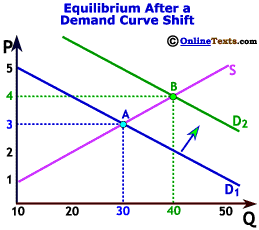
Chapter Three: Notes -- Supply and Demand
- Law of Demand
- Law of Supply
- Equilibrium: Determination of Price and Quantity
- A Shift versus a Movement Along a Demand Curve
- Factors that Shift the Demand Curve
- A Shift versus a Movement Along a Supply Curve
- Factors that Shift the Supply Curve
- Government Regulation of the Market: Price Ceilings and Floors
- Paradoxes Resolved
Why do teachers earn $30,000 per year while some professional athletes earn $18 million per year? Isn't education more important than sports? Why is the price of an ounce of diamonds far higher than the price of an ounce of water? People need water to survive; diamonds are luxuries. These types of paradoxes abound. As you may have guessed by now, the answers lie in the forces of supply and demand.
Have you ever awakened at 3am with a bad headache and had to rush to the pharmacy to buy some aspirin? How did the store know to have aspirin in stock? You certainly didn't phone ahead or even plan on buying the aspirin--certainly not at 3am. How much aspirin do you think consumers purchase each year in the United States? Who coordinates this production to make sure there is enough? What price should be charged for aspirin? In socialist economies, government officials ultimately decide how much aspirin to produce per year and they also decide what price to charge. If the government officials do not plan for your headache at 3am, you are out of luck. In fact, shortages and lack of product selection are commonplace in socialist economies.
The amazing thing about a capitalist system is that there is no central planner. Government officials don't tell businesses how much aspirin to produce nor the price to charge. Private producers figure out production levels and prices on their own. The consumer indirectly tells the producer what she is willing to buy and how much she is willing to pay based on her actual spending patterns. The producer supplies the product if she can make a profit by doing so. The forces of supply and demand coordinate all this activity.
Suppose consumers decide they do not like small fuel-efficient cars anymore. They prefer the larger four-wheel drive sub-utility vehicles. Who tells the auto producers to change their production? You guessed it--the forces of supply and demand hold the answer. Producers see that the smaller cars are sitting on their lots not selling (demand declines) while the large vehicles are selling like hot cakes (demand increases). The producers respond to the changing consumer tastes by discounting the smaller cars and producing more of the larger ones.
Supply and demand analysis is an extremely powerful analytical tool, yet it is little understood and often confused. We begin by noting that there is no "law of supply and demand." There are two separate laws: a law of supply and a law of demand. Each works independently of the other. We first discuss the law of demand, then the law of supply, and see how the laws interact to determine prices and quantities.








